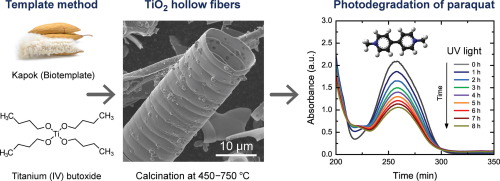当前位置:
X-MOL 学术
›
Mater. Lett.
›
论文详情
Our official English website, www.x-mol.net, welcomes your
feedback! (Note: you will need to create a separate account there.)
Easy synthesis of TiO 2 hollow fibers using kapok as a biotemplate for photocatalytic degradation of the herbicide paraquat
Materials Letters ( IF 2.7 ) Pub Date : 2018-10-01 , DOI: 10.1016/j.matlet.2018.06.089 Sittan Wongcharoen , Gasidit Panomsuwan
Materials Letters ( IF 2.7 ) Pub Date : 2018-10-01 , DOI: 10.1016/j.matlet.2018.06.089 Sittan Wongcharoen , Gasidit Panomsuwan

|
Abstract Titanium dioxide (TiO2) hollow fibers (THFs) were synthesized via a template replication method using natural kapok fiber as a biotemplate. The kapok fibers coated with Ti precursor were calcined at temperatures ranging from 450 °C to 750 °C, resulting in the removal of the kapok template and formation of a hollow structure. Based on the characterization results, calcination temperature played a crucial role in altering the THF crystal structure, surface area, and functional group. Photocatalytic activity of THFs was evaluated by investigating the degradation of the herbicide paraquat under ultraviolet (UV) light. The correlation between physicochemical properties and photocatalytic activity of THFs calcined at different temperatures was investigated and discussed in detail.
中文翻译:

使用木棉作为光催化降解除草剂百草枯的生物模板轻松合成 TiO 2 中空纤维
摘要 以天然木棉纤维为生物模板,通过模板复制法合成了二氧化钛(TiO2)中空纤维(THFs)。将涂有 Ti 前驱体的木棉纤维在 450°C 至 750°C 的温度范围内煅烧,导致木棉模板的去除并形成中空结构。根据表征结果,煅烧温度在改变 THF 晶体结构、表面积和官能团方面起着至关重要的作用。通过研究紫外线 (UV) 光下除草剂百草枯的降解来评估 THF 的光催化活性。详细研究和讨论了在不同温度下煅烧的THFs的理化性质与光催化活性之间的相关性。
更新日期:2018-10-01
中文翻译:

使用木棉作为光催化降解除草剂百草枯的生物模板轻松合成 TiO 2 中空纤维
摘要 以天然木棉纤维为生物模板,通过模板复制法合成了二氧化钛(TiO2)中空纤维(THFs)。将涂有 Ti 前驱体的木棉纤维在 450°C 至 750°C 的温度范围内煅烧,导致木棉模板的去除并形成中空结构。根据表征结果,煅烧温度在改变 THF 晶体结构、表面积和官能团方面起着至关重要的作用。通过研究紫外线 (UV) 光下除草剂百草枯的降解来评估 THF 的光催化活性。详细研究和讨论了在不同温度下煅烧的THFs的理化性质与光催化活性之间的相关性。











































 京公网安备 11010802027423号
京公网安备 11010802027423号